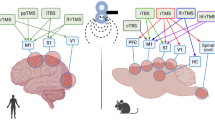We present a brief review of the biological limitations, associated with regeneration of the brain and transplantation of stem cells into it, as well as factors influencing brain plasticity after injury, including epigenetic regulatory mechanisms. Noninvasive transcranial microelectrostimulation provides a potential multisystems stimulus for the endogenous mechanisms of recovery of the brain.
Similar content being viewed by others
References
E. P. Kharchenko and M. N. Klimenko, “Brain plasticity and regeneration,” Nevrol. Zh., 11, No. 6, 37–45 (2006).
S. C. Cramer, M. Sur, B. H. Dobkin, et al., “Harnessing neuroplasticity for clinical applications,” Brain, 134, No. 6, 1591–1609 (2011), doi: https://doi.org/10.1093/brain/awr039.
M. T. Viscomi and M. Molinari, “Remote neurodegeneration: multiple actors for one play,” Mol. Neurobiol., 50, No. 2, 368–389 (2014), doi: https://doi.org/10.1007/s12035-013-8629-x.
J. Graff, D. Kim, M. M. Dobbin, and Tsai Li-Huei, “Epigenetic regulation of gene expression in physiological and pathological brain processes,” Physiol. Rev., 91, No. 2, 603–649 (2011), doi: https://doi.org/10.1152/physrev.00012.2010.
G. Martino, S. Pluchino, L. Bonfanti, and M. Schwartz, “Brain regeneration in physiology and pathology: the immune signature driving therapeutic plasticity of neural stem cells,” Physiol. Rev., 91, No. 4, 1281–130 (2011), doi: https://doi.org/10.152/physrev.00032.2010.
P. Rakic, “Evolution of the neocortex: perspective from developmental biology,” Nat. Rev. Neurosci., 10, No. 10, 724–735 (2009), doi: https://doi.org/10.1038/nrn2719.
S. C. Cramer, “Clinical issues in animal models of stroke and rehabilitation,” ILAR J., 44, No. 2, 83–84 (2003).
D. Van Essen, K. Ugurbil, E. Auerbach, et al., “The human connectome project: a data acquisition perspective,” Neuroimage, 62, No. 4, 2222–2231 (2012), doi: https://doi.org/10.1016/j.neuroimage.2012.02.018.
Brain Research Through Advancing Innovative Neurotechnologies (BRAIN) Working Group, Interim Report, National Institutes of Health, September 16, 2013, http://acd.od.nih.gov/brain.htm.
M. P. Goldberg and B. R. Ransom, “New light on white matter,” Stroke, 34, No. 2, 330–332 (2003).
P. A. Carpentier and T. D. Palmer, “Immune influence on adult neural stem cell regulation and function,” Neuron, 64, No. 1, 79–92 (2009), doi: https://doi.org/10.1016/j.neuron.2009.08.038.
H. L. Mathews and L. W. Janusek, “Epigenetics and psychoneuroimmunology: mechanisms and models,” Brain Behav. Immun., 25, No. 1, 25–39 (2011), doi: https://doi.org/10.1016/j.bbi.2010.08.009.
J. A. Arai and L. A. Feig, “Long-lasting and transgenerational effects of an environmental enrichment on memory formation,” Brain Res. Bull., 85, No. 1–2, 30–35 (2011), doi: https://doi.org/10.1016/j.brainresbull.2010.11.003.
J. L. Rinn and H. Y. Chang, “Genome regulation by long noncoding RNAs,” Annu. Rev. Biochem., 81, 145–166, doi: https://doi.org/10.1146/annurevbiochem-051410-092902.
I. A. Qureshi and M. F. Mehler, “Emerging roles of non-coding RNAs in brain evolution, development, plasticity and disease,” Nat. Rev. Neurosci., 13, No. 8, 528–541, doi: https://doi.org/10.1038/nrn3234.
Y. Tay, J. Rinn, and P. P. Pandolfi, “The multilayered complexity of ceRNA crosstalk and competition,” Nature, 505, No. 7483, 344–352 (2014), doi: https://doi.org/10.1038/nature12986.
M. A. Moskowitz, E. H. Lo, and C. Iadecola, “The science of stroke: mechanisms in search of treatments,” Neuron, 67, No. 2, 181–198 (2010), doi: https://doi.org/10.1016/j.neuron.2010.07.002.
T. G. Liman and M. Endres, “New vessels after stroke: postischemic neovascularization and regeneration,” Cerebrovasc. Dis., 33, No. 5, 492–499 (2012), doi: https://doi.org/10.1159/000337155.
A. Pascual-Leone and R. H. Hamilton, “The metamodal organization of the brain,” Prog. Brain Res., 134, 427–445 (2001).
E. P. Kharchenco, “Transcranial microelectrostimulation induces rapid mechanisms of plasticity in the brain,” Dok. Akad. Nauk, 378, No. 3, 421–423 (2001).
M. M. Ali, K. K. Sellers, and F. Frohlich, “Transcranial alternating current stimulation modulates large-scale cortical network activity by network resonance,” J. Neurosci., 33, No. 27, 11262–11275 (2013), doi: https://doi.org/10.1523/JNEUROSCI.5867-12.2013.
S. Bestmann and E. Feredoes, “Combined neurostimulation and neuroimaging in cognitive neuroscience: past, present and future,” Ann. N. Y. Acad. Sci., 1296, No. 1, 11–30 (2013), doi: https://doi.org/10.1111/nyas.12110.
K. E. Stephan, J. J. Riera, G. Deco, and B. Horwitz, “The brain connectivity workshops: moving the frontiers of computational systems neuroscience,” Neuroimage, 42, No. 1, 1–9 (2008), doi: https://doi.org/10.1016/j.neuroimage.2008.04.167.
S. S. Kollias, H. Alkadhi, T. Jaermann, et al., “Identification of multiple nonprimary motor cortical areas with simple movements,” Brain Res. Rev., 36, No. 2–3, 185–195 (2001).
M. Hallett, “Plasticity of the human motor cortex and recovery from stroke,” Brain Res. Rev., 36, No. 2–3, 169–174 (2001).
R. Chen, L. G. Cohen, and M. Hallett, “Nervous system reorganization following injury,” Neuroscience, 111, No. 4, 761–773 (2002).
J. N. Sanes and J. P. Donoghue, “Plasticity and primary motor cortex,” Annu. Rev. Neurosci., 23, 393–415 (2000).
M. Ning, M. Lopez, J. Cao, et al., “Application of proteomics to cerebrovascular disease,” Electrophoresis, 33, No. 24, 3582–3597 (2012), doi: https://doi.org/10.1002/elps.201200481.
E. Burke and S. C. Cramer, “Biomarkers and predictors of restorative therapy effects after stroke,” Curr. Neurol. Neurosci. Rep., 13, No. 2, 329–338 (2013), doi: https://doi.org/10.1007/s11910-012-0329-9.
A. Quaegebeur, C. Lange, and P. Carmeliet, “The neurovascular link in health and disease: molecular mechanisms and therapeutic implications,” Neuron, 71, No. 3, 406–424 (2011), doi: https://doi.org/10.1016/j.neuron.2011.07.013.
C. Grefkes and G. R. Fink, “Connectivity-based approaches in stroke and recovery of function,” Lancet Neurol., 13, No. 2, 206–216 (2014), doi: https://doi.org/10.1016/S1474-4422(13)70264-3.
Author information
Authors and Affiliations
Corresponding author
Additional information
Translated from Zhurnal Nevrologii i Psikhiatrii imeni S. S. Korsakova, Vol. 117, No. 1, Iss. 2, For the Practicing Doctor, pp. 8–13, January, 2017.
Rights and permissions
About this article
Cite this article
Kharchenko, E.P., Tel’nova, M.N. Brain Plasticity: Limitations and Possibilities. Neurosci Behav Physi 48, 603–607 (2018). https://doi.org/10.1007/s11055-018-0606-4
Published:
Issue Date:
DOI: https://doi.org/10.1007/s11055-018-0606-4




